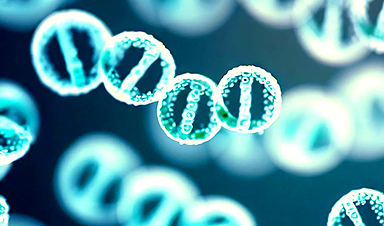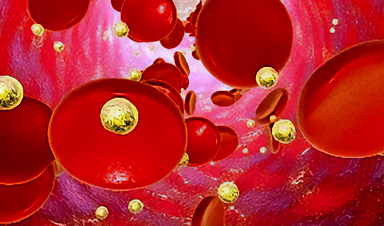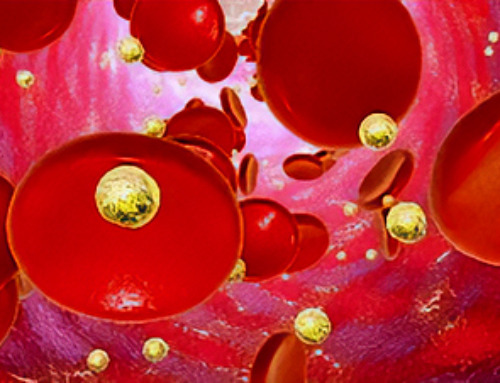Tiny circles of DNA harbor cancer-associated oncogenes and immunomodulatory genes promoting cancer development. They arise during the transformation from pre-cancer to cancer, say Stanford Medicine-led team.
Tiny circles of DNA that defy the accepted laws of genetics are key drivers of cancer formation, according to an international study led by researchers at Stanford Medicine.
The circles, known as extrachromosomal DNA or ecDNA, often harbor cancer-associated genes called oncogenes. Because they can exist in large numbers in a cell, they deliver a super-charged growth signal that can override a cell’s natural programming. They also contain genes likely to dampen the immune system’s response to a nascent cancer, the researchers found.
“This study has profound implications for our understanding of ecDNA in tumor development,” said professor of pathology Paul Mischel, MD. “It shows the power and diversity of ecDNA as a fundamental process in cancer. It has implications for early diagnosis of precancers that put patients at risk, and it highlights the potential for earlier intervention as treatments are developed.”
Mischel is one of six senior authors of the research, which was published recently in the journal Nature. Howard Chang, MD, PhD, professor of genetics and the Virginia and D.K. Ludwig Professor in Cancer Research, is also a senior author. Other senior authors include senior staff scientist Thomas Paulson, PhD, from Seattle’s Fred Hutchison Cancer Center; assistant professor of pediatrics Sihan Wu, PhD, assistant professor at Children’s Medical Center Research Institute at the University of Texas Southwestern Medical Center; professor of computer science and engineering Vineet Bafna, PhD, from UC San Diego; and professor of cancer prevention and director of the Early Cancer Institute Rebecca Fitzgerald, MD, from the University of Cambridge.
“People with ecDNA in their precancerous cells are 20 to 30 times more likely than others to develop cancer,” Chang said. “This is a huge increase, and it means we really need to pay attention to this. Because we also found that some ecDNAs carry genes that affect the immune system, it suggests that they may also promote early immune escape.”
A grand challenge
Deciphering ecDNA’s role in cancer was one of four Cancer Grand Challenges awarded by the National Cancer Institute and Cancer Research UK in 2022. The grand challenges program was launched to bring together researchers from around the world to tackle complex research topics too daunting for any one group. Mischel was awarded $25 million to lead a team of international researchers to learn more about the circles. But first they had to jettison some key genetic principles that have guided the field for nearly 200 years.
“When we think about how a tumor evolves in a patient and in response to treatment, we think of the branching trees of life proposed by Charles Darwin,” Mischel said. “This idea is so powerful that researchers often sequence the DNA from multiple parts of a tumor and draw these trees to learn about its evolution. If a mutation is there at the trunk of the tree and in all of its branches, we assume it is a key driver event in the formation of the tumor; if it is in only some branches, we assume it happened later in tumor development and may not be a good target for drug development.”
But these assumptions hinge on the idea that all of a tumor’s DNA is neatly contained on chromosomes, which are evenly divided among daughter cells each time a cancer cell divides — ensuring that each new cell gets one, and only one, copy of each chromosome.
In contrast, the tiny ecDNA circles swirl in a dividing cell like bubbles circling a bathtub drain and are portioned willy-nilly between the new daughter cells. One may get nearly all the circles; the other, almost none. As the generations accumulate, the evolutionary tree favored by Darwin begins to look decidedly odd, with the appearance of ecDNA-bearing cells sprinkled among the branches like haphazardly hung Christmas lights.
“Some researchers have looked at the evolutionary trees and decided that, because you see it here, but not there, it must be that ecDNA formation is a late event and probably isn’t important when considering treatments,” Mischel said. “Our team thought that interpretation was wrong.”
Pinpointing a reason
To get to the bottom of the tiny circles, Mischel, Chang and their collaborators turned to a specific example of cancer development — people with a condition known as Barrett’s esophagus, which occurs when the cells lining the lower part of the esophagus are damaged by acid reflux and become more like cells lining the intestine than healthy esophageal tissue. About 1% of these people develop esophageal cancer, which is difficult to treat and has a high mortality rate. Because the outcome is so poor, people with Barrett’s esophagus are routinely monitored with endoscopies and biopsies of the abnormal tissue. Because of these frequent biopsies, the researchers had access to tissue samples collected both before and after cancers developed.
The researchers assessed the prevalence of ecDNA, and identified the genes they carried, in biopsies from nearly 300 people with Barrett’s esophagus or esophageal cancer treated at the University of Cambridge or at Seattle’s Fred Hutchison Cancer Center, where individual patients were studied as the cancer developed. They found that the prevalence of ecDNA increased from 24% to 43% in early- versus late-stage esophageal cancer, indicating the continual formation of the DNA circles during cancer progression. More tellingly, they found that 33% of people with Barrett’s esophagus who developed esophageal cancer had ecDNA in their precancerous cells. In contrast, only one out of 40 people who didn’t develop cancer had cells with ecDNA, and that individual passed away due to another cause.
“The conclusions were remarkable,” Mischel said. “We see that ecDNA can arise in these precancerous cells, and that if it is there, the patient is going to get cancer. We also saw the continuous formation of ecDNA as the cancer progresses, indicating that it is advantageous to cancer growth. Finally, we saw that the ecDNA can contain immune-modulatory genes in addition to oncogenes.”
“If a gene is carried on ecDNA, it is very likely to be important for cancer,” Chang said. “These circles are not only giving us new targets for cancer diagnosis and drug development; they are also teaching us what is important for tumor growth.”
What to look at next
The researchers are planning to explore more about how ecDNAs arise in cancer cells and how they work together to make proteins that drive cancer cell growth. They saw that cancers with ecDNA were likely to also have mutations in a protein called p53. Sometimes called “the guardian of the genome,” p53 temporarily halts the cell cycle to allow cells to repair damage or mutations to their DNA before beginning to divide.
“We want to learn more about the landscape of ecDNA in precancers and the risks it confers,” Mischel said. “We also want to know if we can stop its formation or activity; how to improve our ability to detect their presence; how they affect the immune system; and whether there are opportunities for new, novel therapies. There is much more to learn, and our team is excited to tackle all these issues. But what we do know for certain is that these tiny DNA circles are a very big deal in cancer.”
News
Nanocrystals Carrying Radioisotopes Offer New Hope for Cancer Treatment
The Science Scientists have developed tiny nanocrystal particles made up of isotopes of the elements lanthanum, vanadium, and oxygen for use in treating cancer. These crystals are smaller than many microbes and can carry isotopes of [...]
New Once-a-Week Shot Promises Life-Changing Relief for Parkinson’s Patients
A once-a-week shot from Australian scientists could spare people with Parkinson’s the grind of taking pills several times a day. The tiny, biodegradable gel sits under the skin and releases steady doses of two [...]
Weekly injectable drug offers hope for Parkinson’s patients
A new weekly injectable drug could transform the lives of more than eight million people living with Parkinson's disease, potentially replacing the need for multiple daily tablets. Scientists from the University of South Australia [...]
Most Plastic in the Ocean Is Invisible—And Deadly
Nanoplastics—particles smaller than a human hair—can pass through cell walls and enter the food web. New research suggest 27 million metric tons of nanoplastics are spread across just the top layer of the North [...]
Repurposed drugs could calm the immune system’s response to nanomedicine
An international study led by researchers at the University of Colorado Anschutz Medical Campus has identified a promising strategy to enhance the safety of nanomedicines, advanced therapies often used in cancer and vaccine treatments, [...]
Nano-Enhanced Hydrogel Strategies for Cartilage Repair
A recent article in Engineering describes the development of a protein-based nanocomposite hydrogel designed to deliver two therapeutic agents—dexamethasone (Dex) and kartogenin (KGN)—to support cartilage repair. The hydrogel is engineered to modulate immune responses and promote [...]
New Cancer Drug Blocks Tumors Without Debilitating Side Effects
A new drug targets RAS-PI3Kα pathways without harmful side effects. It was developed using high-performance computing and AI. A new cancer drug candidate, developed through a collaboration between Lawrence Livermore National Laboratory (LLNL), BridgeBio Oncology [...]
Scientists Are Pretty Close to Replicating the First Thing That Ever Lived
For 400 million years, a leading hypothesis claims, Earth was an “RNA World,” meaning that life must’ve first replicated from RNA before the arrival of proteins and DNA. Unfortunately, scientists have failed to find [...]
Why ‘Peniaphobia’ Is Exploding Among Young People (And Why We Should Be Concerned)
An insidious illness is taking hold among a growing proportion of young people. Little known to the general public, peniaphobia—the fear of becoming poor—is gaining ground among teens and young adults. Discover the causes [...]
Team finds flawed data in recent study relevant to coronavirus antiviral development
The COVID pandemic illustrated how urgently we need antiviral medications capable of treating coronavirus infections. To aid this effort, researchers quickly homed in on part of SARS-CoV-2's molecular structure known as the NiRAN domain—an [...]
Drug-Coated Neural Implants Reduce Immune Rejection
Summary: A new study shows that coating neural prosthetic implants with the anti-inflammatory drug dexamethasone helps reduce the body’s immune response and scar tissue formation. This strategy enhances the long-term performance and stability of electrodes [...]
Scientists discover cancer-fighting bacteria that ‘soak up’ forever chemicals in the body
A family of healthy bacteria may help 'soak up' toxic forever chemicals in the body, warding off their cancerous effects. Forever chemicals, also known as PFAS (per- and polyfluoroalkyl substances), are toxic chemicals that [...]
Johns Hopkins Researchers Uncover a New Way To Kill Cancer Cells
A new study reveals that blocking ribosomal RNA production rewires cancer cell behavior and could help treat genetically unstable tumors. Researchers at the Johns Hopkins Kimmel Cancer Center and the Department of Radiation Oncology and Molecular [...]
AI matches doctors in mapping lung tumors for radiation therapy
In radiation therapy, precision can save lives. Oncologists must carefully map the size and location of a tumor before delivering high-dose radiation to destroy cancer cells while sparing healthy tissue. But this process, called [...]
Scientists Finally “See” Key Protein That Controls Inflammation
Researchers used advanced microscopy to uncover important protein structures. For the first time, two important protein structures in the human body are being visualized, thanks in part to cutting-edge technology at the University of [...]
AI tool detects 9 types of dementia from a single brain scan
Mayo Clinic researchers have developed a new artificial intelligence (AI) tool that helps clinicians identify brain activity patterns linked to nine types of dementia, including Alzheimer's disease, using a single, widely available scan—a transformative [...]





















